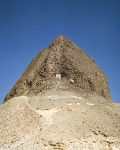El-Lahun
Archaeology »
Archaeological Monuments » El-Lahun
El-Lahun - Egypt
El-Lahun is located in Faiyum.
El-Lahun monument was established on 1889-90.
Primary threats to El-Lahun :
It became so popular that the Dynasty XII kings Senwosret II and Amenemhet III chose to site pyramids here as their final resting places, at the far reaches of the existing pyramid fields to the north.
Historical facts of El-Lahun :
- El-Lahun, also known as Illahun or Kahun, is an archaeological site located in the Faiyum Governorate of Egypt. It is situated around 80 kilometers southwest of Cairo and was once an important settlement during ancient times. El-Lahun is primarily renowned for its association with the pyramid of Senusret II, a pharaoh of the Twelfth Dynasty of Egypt. Here are some historical facts about El-Lahun:
- Pyramid Complex of Senusret II : The most significant feature of El-Lahun is the pyramid complex of Senusret II, who reigned from approximately 1897 to 1878 BCE. The pyramid, measuring about 105 meters on each side, was the centerpiece of the complex. It was surrounded by various structures, including a mortuary temple, a causeway, and a subsidiary pyramid.
- Planned Settlement : El-Lahun was not merely a funerary complex but also a planned settlement. It served as a residence for the workers and officials involved in the construction and maintenance of the pyramid. The layout of the town was well-organized, with straight streets and houses built in a grid pattern.
- Middle Kingdom Capital : During the Twelfth Dynasty, El-Lahun briefly served as the capital of Egypt. It functioned as a royal administrative center, overseeing the agricultural and economic activities of the surrounding region. The proximity to the Faiyum Oasis made it a strategic location for the pharaohs to control the fertile lands and manage irrigation systems.
- Domestic Architecture : El-Lahun provides valuable insights into the domestic architecture of ancient Egypt. The houses discovered at the site were made of mud bricks and featured multiple rooms, courtyards, and sometimes even multiple stories. Some houses had separate quarters for the wealthy residents and their servants.
- Artifacts and Discoveries : Excavations at El-Lahun have unearthed a wealth of artifacts that shed light on the daily life and culture of the ancient Egyptians. These include pottery, jewelry, tools, statues, and papyrus documents. One of the most famous discoveries is the Kahun Gynecological Papyrus, which contains medical information and prescriptions related to women's health.
- Mummy Cache : In 1889, archaeologist Flinders Petrie discovered a hidden cache of mummies in El-Lahun. The mummies belonged to various individuals, including the pharaohs Senusret II and Amenemhat III, as well as several members of the royal family. The cache provided valuable information about the burial practices and mummification techniques of the time.
- Abandonment and Rediscovery : El-Lahun was abandoned shortly after the end of the Twelfth Dynasty. Over time, the site became covered by sand and was largely forgotten. It was not until the 19th century that the ruins of El-Lahun were rediscovered and excavated by archaeologists, revealing its historical significance.
- Influence on Later Periods : The architectural and urban planning techniques employed at El-Lahun had a lasting impact on subsequent periods of Egyptian history. Elements of the town's design can be seen in later settlements, particularly in the New Kingdom and Ptolemaic periods.
- In conclusion, El-Lahun holds a significant place in Egypt's history, primarily due to its association with the pyramid complex of Senusret II and its status as a planned settlement and administrative center. The artifacts and discoveries made at the site provide valuable insights into ancient Egyptian life and culture. El-Lahun's historical importance and archaeological significance continue to captivate researchers and enthusiasts alike.

